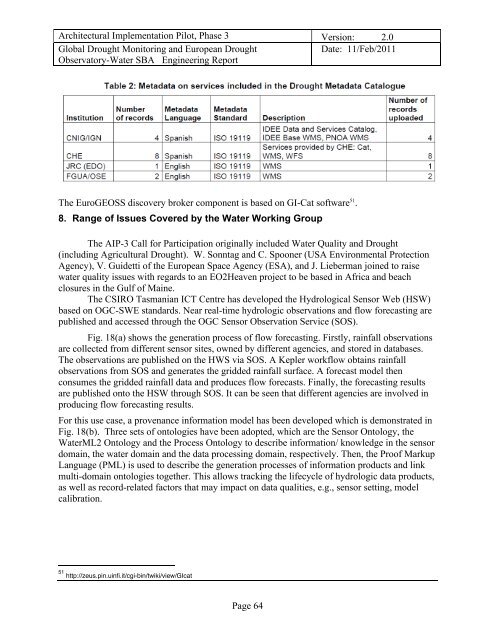Global Drought Monitoring Service through the GEOSS Architecture ...
Global Drought Monitoring Service through the GEOSS Architecture ...
Global Drought Monitoring Service through the GEOSS Architecture ...
Create successful ePaper yourself
Turn your PDF publications into a flip-book with our unique Google optimized e-Paper software.
Architectural Implementation Pilot, Phase 3 Version: 2.0<br />
<strong>Global</strong> <strong>Drought</strong> <strong>Monitoring</strong> and European <strong>Drought</strong><br />
Observatory-Water SBA Engineering Report<br />
Date: 11/Feb/2011<br />
The Euro<strong>GEOSS</strong> discovery broker component is based on GI-Cat software 51 .<br />
8. Range of Issues Covered by <strong>the</strong> Water Working Group<br />
The AIP-3 Call for Participation originally included Water Quality and <strong>Drought</strong><br />
(including Agricultural <strong>Drought</strong>). W. Sonntag and C. Spooner (USA Environmental Protection<br />
Agency), V. Guidetti of <strong>the</strong> European Space Agency (ESA), and J. Lieberman joined to raise<br />
water quality issues with regards to an EO2Heaven project to be based in Africa and beach<br />
closures in <strong>the</strong> Gulf of Maine.<br />
The CSIRO Tasmanian ICT Centre has developed <strong>the</strong> Hydrological Sensor Web (HSW)<br />
based on OGC-SWE standards. Near real-time hydrologic observations and flow forecasting are<br />
published and accessed <strong>through</strong> <strong>the</strong> OGC Sensor Observation <strong>Service</strong> (SOS).<br />
Fig. 18(a) shows <strong>the</strong> generation process of flow forecasting. Firstly, rainfall observations<br />
are collected from different sensor sites, owned by different agencies, and stored in databases.<br />
The observations are published on <strong>the</strong> HWS via SOS. A Kepler workflow obtains rainfall<br />
observations from SOS and generates <strong>the</strong> gridded rainfall surface. A forecast model <strong>the</strong>n<br />
consumes <strong>the</strong> gridded rainfall data and produces flow forecasts. Finally, <strong>the</strong> forecasting results<br />
are published onto <strong>the</strong> HSW <strong>through</strong> SOS. It can be seen that different agencies are involved in<br />
producing flow forecasting results.<br />
For this use case, a provenance information model has been developed which is demonstrated in<br />
Fig. 18(b). Three sets of ontologies have been adopted, which are <strong>the</strong> Sensor Ontology, <strong>the</strong><br />
WaterML2 Ontology and <strong>the</strong> Process Ontology to describe information/ knowledge in <strong>the</strong> sensor<br />
domain, <strong>the</strong> water domain and <strong>the</strong> data processing domain, respectively. Then, <strong>the</strong> Proof Markup<br />
Language (PML) is used to describe <strong>the</strong> generation processes of information products and link<br />
multi-domain ontologies toge<strong>the</strong>r. This allows tracking <strong>the</strong> lifecycle of hydrologic data products,<br />
as well as record-related factors that may impact on data qualities, e.g., sensor setting, model<br />
calibration.<br />
51 http://zeus.pin.uinfi.it/cgi-bin/twiki/view/GIcat<br />
Page 64




